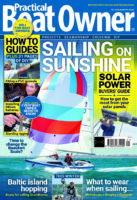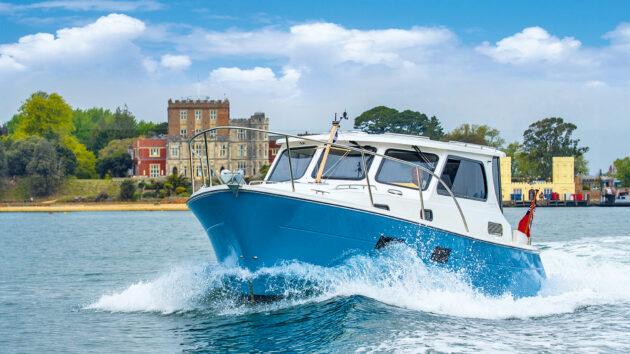Jake Kavanagh looks at the main buying choices for your first motorboat, including interior layout options, style of hull, type of engine, and new vs used.
There are many reasons why people want to buy a motorboat – the recent Covid-19 pandemic (and a generally unstable world) being one of them.
With immediate turn-key power, and usually plenty of it, a mile-eating top speed, ample range, and often very comfortable accommodation, a motorboat can become a home-from-home.
During the pandemic, many also became remote offices and ways to escape lockdown, so sales rocketed. Some people were even buying a 50-footer as their very first boat, because they wanted the internal space.
For those looking to move from sail to power, or just get out on the water, the choice of motorboats is bewildering.
However, experienced sailors generally have a good idea of the type of boat they’re looking for, while newcomers will also know whether they want a boat for day trips or more serious cruising.
For starters, do they need one with a cabin, or just open, like a RIB (Rigid-hulled Inflatable Boat)?
Some will be buying a boat exclusively for use on rivers and canals, giving them access to thousands of miles of gentle inland cruising throughout Europe. Others are finding a motorboat a comfortable way to live aboard all year round.
Why choose a motorboat?
Many years ago when I worked for Motor Boats Monthly magazine our reader surveys revealed just how many enthusiasts had switched from sail to power.
When we asked why, some said it was the lack of leisure time. For example, a 20-hour beat to windward in a yacht could be replaced with a four-hour direct route in a planing motorboat. The crew would also be fresher on arrival, with no red-eye watchkeeping shifts required.
For others, it was having a more stable platform, and not having to brace themselves in a loo canted at 45° (another reason why sailing catamarans are proving increasingly popular). As age crept upon them, our readers didn’t want to have to work sheets and halyards, despite the availability of highly efficient electric winches.
Meanwhile, younger boaters loved the thrill of zipping over the water at high speed, being able to run their small powerboat safely onto the beach for a picnic lunch and enjoying a bit of wakeboarding on the way back.
For families, the design of a motorboat often lends itself to providing more practical space for daily living.
The Scandinavian cruiser designs, for example, typified having the galley and saloon all combined within the raised cabin and wheelhouse, which is on the same level as the aft cockpit.
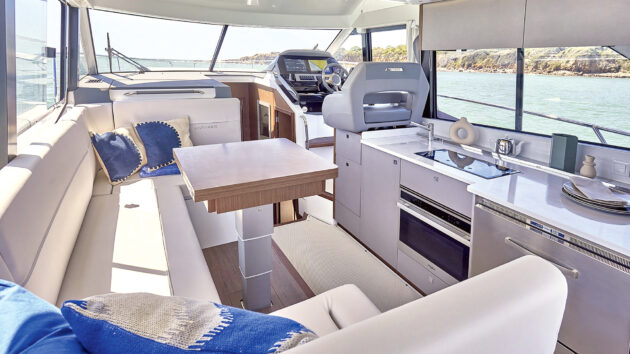
Modern motorboats, typified here by the Bavaria Antares 12, often favour the raised saloon design. Photo: Bavaria.
With the summer season so short, the idea was that the main cabin would be a kitchen/veranda with panoramic views of the seascape. Many sailing yacht designers have since copied this concept.
Modern motorboats have also become far more expandable, with powered sunroofs, drop-down bulwarks forming balconies, and large bathing platforms that can be retracted to reduce the overall length for marina charges.
While there has always been a bit of friendly joshing between motorboaters and sailors, many becalmed sailors find themselves becoming motorboaters anyway, so already understand the need for reliable auxiliary propulsion.
So how does someone new to this type of boating decide on their ideal motorboat?
Considerations when buying your first motorboat
Just as in the automotive sector, the choice of types and models is vast.
However, there is more to consider with a motorboat. After all, how many cars have two, three or even four engines?
As part of Motor Boat Monthly’s reader service, we’d often field calls from people who wanted to buy a boat for the first time. Our first question would be to ask about their priorities.
Many would start with ‘I would like really good seakeeping,’ which is commendable and probably a throwback from their sailing days, but should not necessarily be top of the list.
After all, how many hours of your boating will be spent battling with gales, and how many spent relaxing in a generous saloon or a spacious cockpit?
The main steer should be ‘how do I intend to spend most of my time on board?’ If you want to cover hundreds of miles each season and expect to bash into a few boisterous seas, then move good seakeeping up the list.
If you want to focus on having a relaxing time with the family in some idyllic anchorages, or berthed in comfortable marinas, then prioritise the accommodation instead.
Cabin, cuddy, or open?
Where will you eat, sleep and use the toilet? This is a main consideration from the get-go.
If you just want a motorboat for a few short local trips to visit beaches or quayside eateries, then an open boat or a cuddy-cabin (a small shelter) will suffice. If you want to sleep comfortably on board, you’ll need a suitable cabin, a kitchen (galley) of some kind, and a toilet, preferably with a degree of privacy.
The type of accommodation required immediately narrows the field.
Fast, medium, or slow?
When it comes to performance, you’ll hear five terms: displacement, semi-displacement (or semi-planing), planing and – more recently – foiling. The images below describe each one and give an idea as to what type of vessel would best suit your boating style.
Fast boats can go slow if required, but mo matter how much power, displacement boats can’t exceed their hull speed, so unless you’re happy cruising everywhere at around 5-6 knots, you might want to keep the option for speed open.
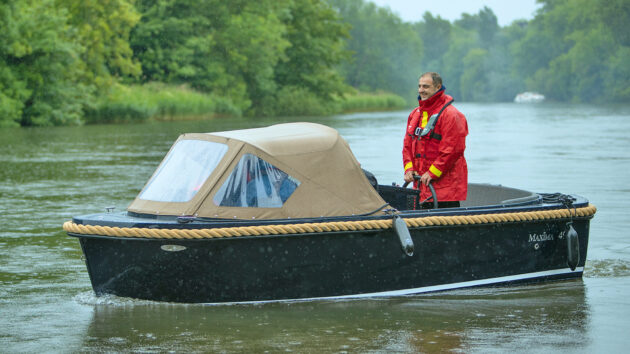
Photo: Jake Kavanagh.
You can do this by choosing a hull shape that can either partially or fully lift out of the water under way as the power increases.
Semi-displacement (or semi-planing) boats can lift a portion of their hull enabling faster speeds.
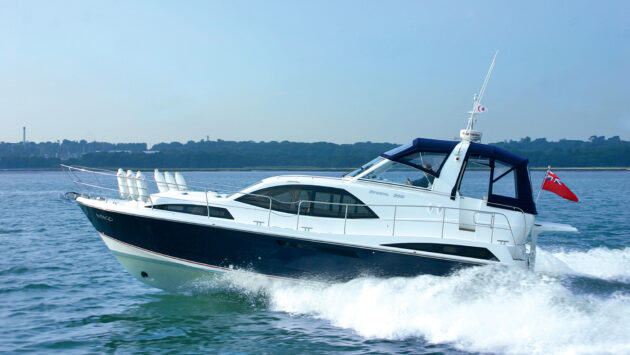
Photo: Broom.
Planing boats bring the stern up near the surface and ‘semi skim’ at high speeds.
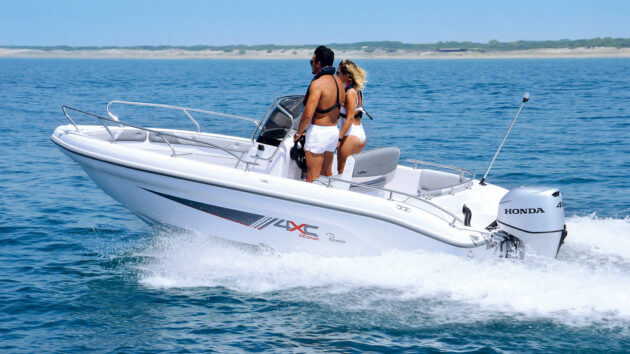
Photo: Jake Kavanagh.
Foiling craft lift the hull completely out of the water. ‘Flight control’ is handled by computer.
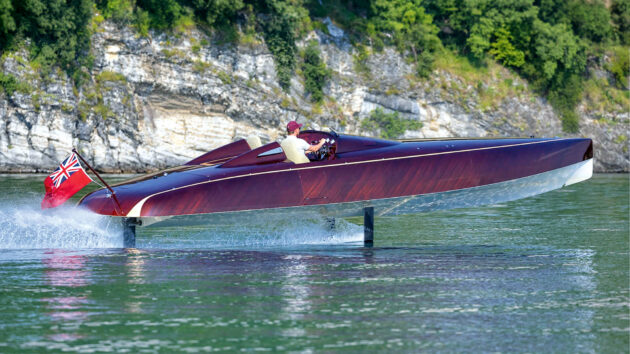
Photo: Spirit Yachts
Petrol, diesel, hybrid, electric?
Fuel is expensive, and marine engines are not particularly efficient at transferring their power to the water, so a typical 40hp marine diesel will burn about 4gal (17.8lt) an hour at full power, but up to 40% less at cruising speed. This would give your displacement boat an automotive equivalent of around 5mpg. Planing motorboats with twin 250hp diesels can easily see off 1gal per mile.
While this sounds expensive, in the greater scheme of things it’s a matter of perspective.
Firstly, the average annual engine hours for a UK-based motorboat are just 50. That’s less than a lorry clocks in a fortnight, so your engine will probably corrode out long before it wears out.
Secondly, fuel costs are relative. I was recently quoted £12,000 to replace the stainless steel rigging on my 39ft yacht, and £600 for each spreader. Sail repairs were also around £1,500. I could buy several years’ worth of fuel for that kind of outlay, even for a fast motorboat.
For most inboard-powered boats, diesel is the motor of choice, as the fuel is generally safer to use and more widely available at the quayside.
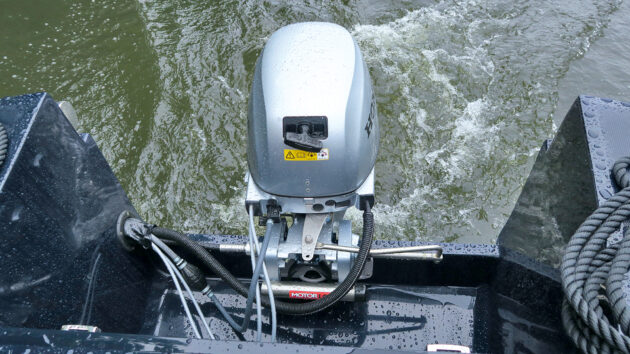
Modern petrol outboards are far more frugal with fuel than their predecessors, and at tickover barely make a sound. Photo: Jake Kavanagh.
Many fast American sportsboats, however, will have a powerful petrol inboard instead, the idea being that these were cheaper to source, and the price difference compared to a diesel installation would buy a lot of fuel.
Many boaters prefer the quieter and less fume-laden running of a petrol engine, and find them easier to maintain, too.
However, the latest common-rail diesels are proving very quiet and economical, with far less exhaust due to electronic fuel management.
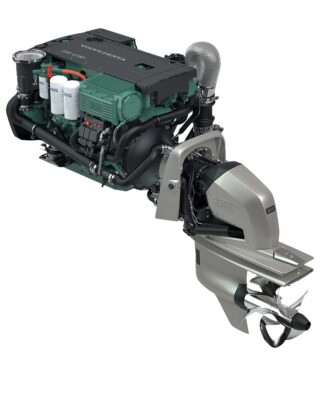
Modern diesel engines like the Volvo Penta D4 use common-rail technology for clean, quiet running and good fuel economy. Photo: Volvo Penta.
Petrol outboards are now quieter and more fuel efficient than ever, with a wide range of power outputs, and the advantage of freeing up space inside the boat.
The sterndrive (a steerable drive leg at the back of the boat) also frees up accommodation space inside.
Recently coming to the fore is electric propulsion, but this type of drive remains relatively new and with limited range. Hybrids and range extenders are available, and proving increasingly popular, especially as many sailors are now driving hybrid cars.
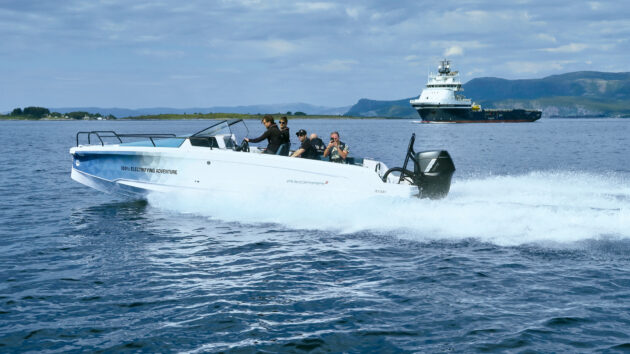
Electric outboards are evolving fast, here a Norwegian Evo powering a stepped-hull Axopar. Current battery technology gives a full-speed run time of about an hour, with fast recharging available. Photo: Jake Kavanagh.
Marina, swinging mooring or driveway?
A vital consideration is where your boat will be kept.
Experienced boat owners may already have a suitable berth arranged. The cost of keeping your boat in a fully serviced marina will eat up a large part of the annual budget, although many boat owners view the marina experience as part of the enjoyment.
Being able to spend a weekend pottering on the ‘cottage by the water,’ even without taking her out, with often luxurious facilities ashore, is part of the fun.
Some owners buy a small motorboat and keep it on a trailer at home (having checked if there are any local bylaws against this).
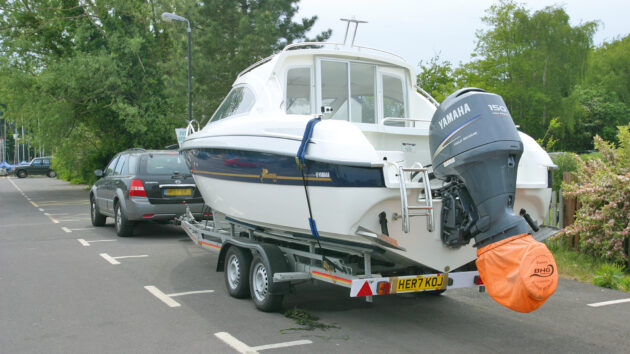
Being able to trail your boat and keep it on your driveway will open new cruising grounds while keeping costs low. Photo: Jake Kavanagh.
Others are lucky enough to have a cheap yacht club mooring or one with the local harbour authority.
Motorboats are no different to yachts in terms of leaving them unattended, so could happily use a swinging mooring, although many owners now use small solar panels to ensure the starter batteries are always topped up.
A very good way to keep your motorboat in good condition is to invest in a dry-stack mooring.
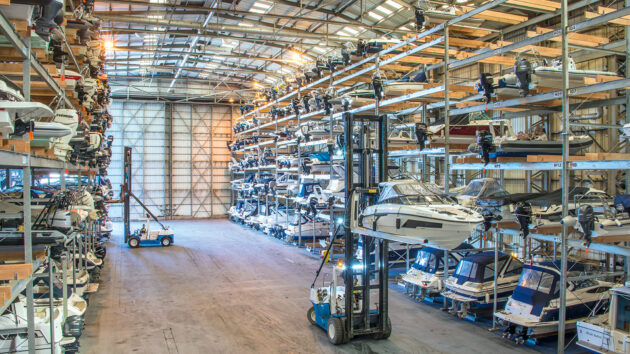
Dry stack berthing, like at Trafalgar Dry Stack in Portsmouth, offers quick launching and no antifouling required. Photo: Trafalgar Wharf.
The boat is kept in a rack, either indoors or out, and is launched by a special forkhoist. Boats of up to around 30ft can be stored this way, with none of the usual issues of fouling or corrosion. The bottom line is always ensure you have a mooring lined up before your purchase, and be realistic with the annual running costs.
Getting a taster before buying your first motorboat
For people completely new to motorboating, there are several ways to decide if you like it before a major purchase.
A very practical way is to take a motorboating course with an RYA-recognised sea school. These can usually offer several types of powerboat training, from fast, open RIBS through to twin-engine motor cruisers.
Apart from the practical experience, you’ll also be able to pick the instructor’s brain and maybe those of fellow students.
Another good way is to join a powerboat club as an associate member and get a few rides out in various club member’s boats. Alternatively, join one of the growing network of boat clubs that are popping up all over the world.
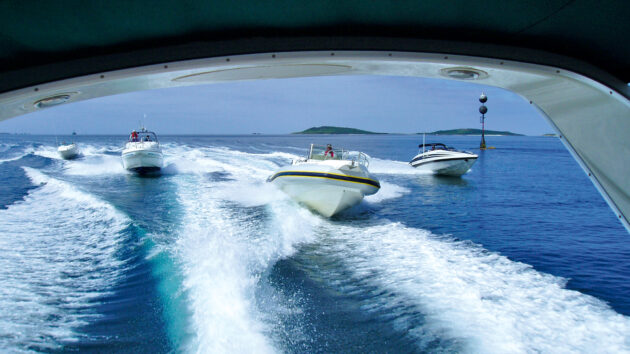
The Solent Powerboat Club is very active and arranges regional cruises. Photo: Pathfinder Powerboat Club.
Not only can you book as many trips as you can manage, but you’ll also be able to try different models of boat, in various locations, both here and abroad.
Many club members go on to buy their favourite boat from the wide selection they’ve tried, knowing it’s ideal for their type of boating.
Brokers and distributors can also arrange for test drives if a particular boat has caught your attention, and boat shows will often have a ‘try-a-boat’ event that will at least give you a start in the decision-making process.
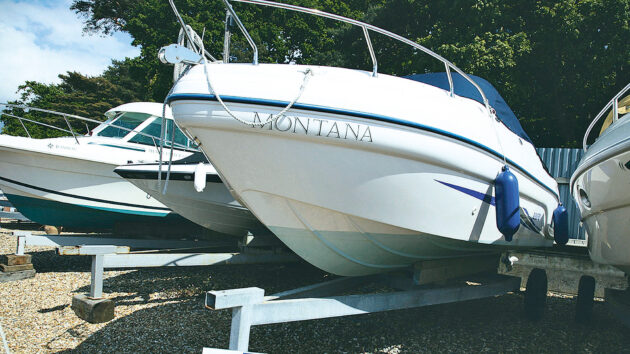
Buying through a reputable broker means there is often ongoing customer support. Photo: David Harding.
So, having settled on your ideal type of boat, should you buy new or used… or something in need of a lot of work?
Buying your first motorboat new
The market for new boats has changed a lot over the last decade or so. There was a time when boats were in such demand that they were being sold almost as fast as they could be made. As a result, many were mass-produced with a limited choice of options.
Nowadays, anyone buying a new boat will be offered a comprehensive choice of interior and exterior fit-outs, often with the ability to semi-customise.
The advantage of buying new is that everything on board will carry a manufacturer’s warranty, the paperwork (VAT, proof or ownership etc) will all be sorted by the boatbuilder, and the dealer or distributor will be able to fix any snags and ‘hold the customer’s hand’ as the boat starts its life afloat.
Good partnerships are usually established between the owner and builder, sometimes with an active owner’s club running in parallel, and the option to part exchange for another model in the range is usually an option.
The main attraction of a new build is having a boat exactly as you want it, with the systems new and unused and professionally configured to your style of boating.
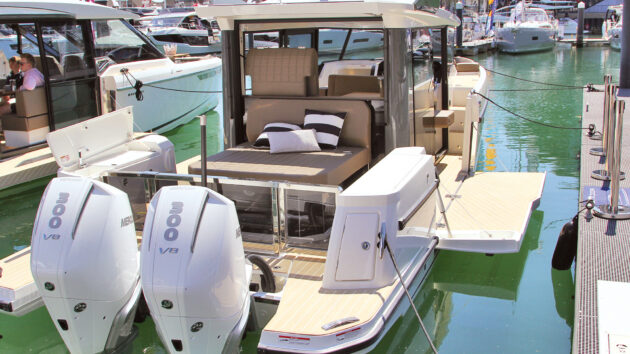
A new semi-custom build means you can specify fitout, from fold-down gunwales to choices of upholstery like in this Fjord 39. Photo: Jake Kavanagh.
This is where the boat show comes into its own.
New motorboats of all shapes, types and sizes will be available for you to inspect, and possibly even try, and all in one place.
The main boatbuilders sell their boats through approved dealers, sometimes with several outlets in each country. The dealer’s job is to ensure the sale is as smooth as possible, with the purchase backed up with ongoing customer support.
For example, Ancasta International was formed in the late 1980s, before the Internet was being widely used, and sells around 50-70 new power and sail boats a year. It stocks brands like Beneteau, San Lorenzo and Scorpion, with ongoing dealer support and a motorboat club.
“We have quite a simple philosophy when a new customer walks in through the door,” explained managing director Nick Griffith. “We don’t see their signature on a contract as just one boat sale. If we do our job properly, it means perhaps three or four more boat sales over the coming years as the same customer progresses to ever-larger models.”
Buying your first motorboat used
There are two ways to buy a used motorboat: through a yacht broker or a private sale.
The safest way is through an Association of Brokers and Yacht Agents (ABYA) affiliated yacht broker, who will do their best to ensure there are no issues with undischarged mortgages or unreported damage.
They can also help arrange finance, and sometimes even a berth. If you have a specific boat in mind, they’ll often be able to search a comprehensive database and send you the details when one becomes available.
Many broker websites allow customers to take a virtual tour of a boat they’re interested in, either by watching a video made by the brokers themselves, or via an interactive programme that allows you to pan and tilt and zoom on images as you go.
What you can’t do is lift floorboards and poke into the back of cupboards, but you can usually look at the engine and see its general condition. If the boat is being videoed out of the water, even better.
Look closely at the inventory, too. Sometimes a boat is photographed or filmed with kit that isn’t listed in the sale, such as a nice tender and outboard, or a brand new liferaft.
Several marinas and harbours host used boat shows – like boatpoint’s Southampton Used Boat Show – at the start or end of the boating season, inviting potential customers to visit free of charge and inspect as many boats as they want.
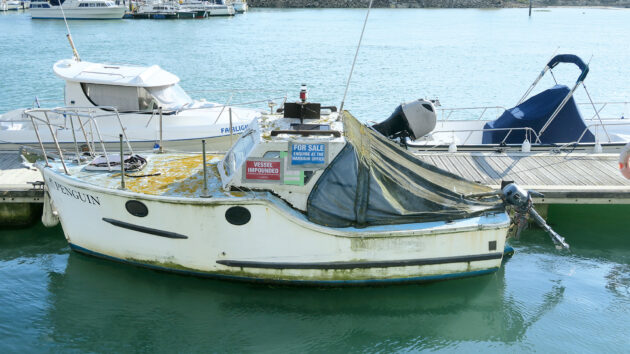
There are plenty of bargains to be had for DIY enthusiasts. Photo: Jake Kavanagh.
Private sales can also provide a suitable boat, although the buyer must be more vigilant.
There are plenty of bargains available on various websites such as eBay or Gumtree, or on postcards in newsagents’ windows, private ads in local newspapers and on noticeboards in yacht clubs and harbour offices.
Sometimes there is a ‘For Sale’ sign on the boat itself, although, for the seller, it’s usually a good idea to suggest the price as well as a contact number.
With tales of people selling boats that aren’t theirs, or which still have a hefty finance package in place, the buyer will need to see comprehensive proof of the title documents that prove ownership, evidence of the boat’s VAT status and evidence that the vessel complies with Recreational Craft Directive/Recreational Craft Regulations and CE/UKCA mark requirements.
In the UK, there is no official registration scheme, so a boat’s heritage is quite easy to disguise for those out to deceive.
Thankfully, most sales are made in good faith, and the RYA has some useful guides to help achieve a successful transaction. It can also advise about VAT issues that can arise when buying or selling a boat overseas.
Getting a survey of your first motorboat
Once you have set your heart on a used motorboat, it’s best to get a professional marine survey.
Many surveyors will offer a comprehensive machinery inspection too. The usual route – just as with a house sale – is to offer a price ‘subject to survey.’ If the surveyor finds some serious issues, this gives the potential buyer the chance to negotiate a lower price, or simply walk away.
The cost of the survey will have to be borne by the buyer, but it could save a big repair bill further down the line, or prevent them from buying a disaster.
Incidentally, when it comes to motorboat engine hours, the reverse of a car applies.
It’s often preferable to see the total engine hours much higher than expected. This usually means a passionate owner who is likely to have maintained the engine(s) well to avoid downtime.
Low engine hours (much less than the average 50 a year) on the other hand could mean stale fuel has sat in tanks for long periods, a lack of servicing (based on hours run) and issues with ‘standing faults.’ This could include corrosion, cracked rubber seals, diesel bug or the seizing of parts that rarely get to move.
Finally, and close to many PBO readers’ hearts, is the bargain boat, or ‘recoverable wreck.’
Many older motorboats will have engines that will be much easier to strip down and repair than their modern equivalents, so for those who know their way around the internal combustion engine, this is a good way to own a lot of boat for not a lot of money.
Be aware that spares for many older engines may be in short supply, though, and in some cases it may prove cheaper to simply fit a new – or professionally reconditioned – drive train. Corrosion is usually the make-or-break factor with the machinery on a project boat.
The bottom line when buying your first motorboat
Owning a motorboat is a good way to make fast passages and transition easily from sail to power. Fuel is costly, but not a major factor when everything else is taken into consideration.
New boats will provide you with exactly what you want, usually with excellent dealer backup, while used boats sourced through a dealer can represent very good value for money.
Wrecks, of course, are everywhere.
Try and test the type of boat you would like to own first, to ensure it is exactly what you want, and then get out there and have some fun!
Jake Kavanagh is the former editor of Motor Boats Monthly and has spent 35 years as a full-time marine journalist. He is the technical editor for International Boat Industry (IBI) magazine and is an author and illustrator, specialising in marine themes.
Tips for drying out in a motorboat
Gilbert Park shares his tips for allowing motorboats to dry out safely
Why we swapped sail for power: 10 motorboaters explain their big switch
Many moons ago I had a premonition that Hunter Boats ought to build a classy little motorboat for customers who…
My first motorboat – two sailors on how and why they converted to powerboating
Retired doctor and practical motorboat owner Gilbert Park has undertaken numerous DIY challenges on board his various motorboats, publishing several…
Want to read more articles like this?

A subscription to Practical Boat Owner magazine costs around 40% less than the cover price.
Print and digital editions are available through Magazines Direct – where you can also find the latest deals.
PBO is packed with information to help you get the most from boat ownership – whether sail or power.
-
-
-
- Take your DIY skills to the next level with trusted advice on boat maintenance and repairs
- Impartial, in-depth gear reviews
- Practical cruising tips for making the most of your time afloat
-
-
Follow us on Facebook, Instagram, TikTok and Twitter

